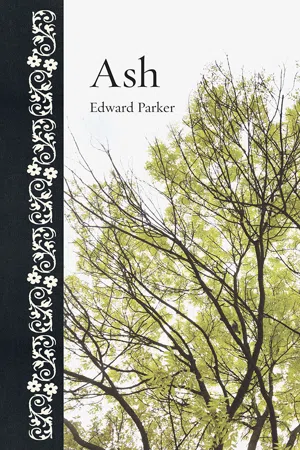
This is a test
- English
- ePUB (mobile friendly)
- Available on iOS & Android
eBook - ePub
Botanical
Book details
Book preview
Table of contents
Citations
About This Book
Ash is a beautifully illustrated account of the botanical and cultural faces of the ash tree. The book maps the tree's evolution and geographical spread across the entire Northern Hemisphere over the last 44 million years, and describes the 43 species that grace the planet today. Edward Parker also explores the botany, cultural history, and medicinal uses of the tree, from its significance in ancient Indo-European cultures, to its remarkable properties in treating Alzheimer's disease. In addition he looks at topical issues, such as the devastating effects that the spread of the emerald ash borer beetle and the ash dieback fungal infection are having on Northern Hemisphere forests.
Frequently asked questions
At the moment all of our mobile-responsive ePub books are available to download via the app. Most of our PDFs are also available to download and we're working on making the final remaining ones downloadable now. Learn more here.
Both plans give you full access to the library and all of Perlego’s features. The only differences are the price and subscription period: With the annual plan you’ll save around 30% compared to 12 months on the monthly plan.
We are an online textbook subscription service, where you can get access to an entire online library for less than the price of a single book per month. With over 1 million books across 1000+ topics, we’ve got you covered! Learn more here.
Look out for the read-aloud symbol on your next book to see if you can listen to it. The read-aloud tool reads text aloud for you, highlighting the text as it is being read. You can pause it, speed it up and slow it down. Learn more here.
Yes, you can access Botanical by Edward Parker in PDF and/or ePUB format, as well as other popular books in Biological Sciences & Science General. We have over one million books available in our catalogue for you to explore.
Information
References

Introduction
1 Jesse L. Byock, trans., The Prose Edda (London, 2005), p. 18.
2 Darl J. Dumont, ‘The Ash Tree in Indo-European Culture’, Mankind Quarterly, XXXII/4 (Summer 1992), pp. 323–6, www.musaios.com, accessed 16 June 2019.
3 Ibid.
4 Alexander F. Chamberlain, The Child and Childhood in Folk-thought (Frankfurt, 2018), p. 132.
5 Melvin Hodge, ‘Uses of Plants by the Indians of Missouri River Region’, 33rd Annual Report of the Bureau of American Ethnology, Smithsonian Institution, U.S., Government Printing Office (1919), p. 109.
6 Ibid.
7 Fred Hageneder, Yew: A History (Stroud, 2007), p. 104.
8 Richard A. Gabriel, Thutmose 111: A Military Biography of Egypt’s Greatest Warrior King (Lincoln, NE, 2009), p. 13.
9 ‘European Wood Pasture (Silvopasture)’, Case Studies (2012), www.coppiceagroforestry.com, accessed 18 July 2019.
10 Thomas A. Kinney, The Carriage Trade: Making Horse-drawn Vehicles in America (Baltimore, MD, 2004), p. 34.
11 K. N. Venugopala, V. Rashmi and B. Odhav, ‘Review of Natural Coumarin Lead Compounds for Their Pharmacological Activity’, BioMed Research International (March 2013), Article id. 963248.
12 ‘Sweet Approach’, www.clinicrowd.info, accessed 9 April 2019.
13 Peter A. Thomas, ‘Ashes to Ashes’, www.keele.ac.uk, 23 March 2016.
1 The Botany of Fraxinus
1 Carl Linnaeus, Species plantarum (Stockholm, 1753).
2 Eva Wallander, ‘Systemics of Fraxinus (Oleaceae) and the Evolution of Dioecy’, Plant Systematics and Evolution, CCLXXIII (2008), pp. 25–49.
3 A. Lingelsheim, ‘Oleaceae-Oleoideae-Fraxineae’, in A. Engler, Das Pflanzenreich, IV/243 (Leipzig, 1920), pp. 1–65.
4 Robert E. Farmer, Seed Ecophysiology of Temperate and Boreal Zone Forest Trees (Boca Raton, FL, 1997), p. 47.
5 Wallander, ‘Systemics of Fraxinus’.
6 Ibid.
7 Ibid.
8 Ibid.
9 Ibid.
10 W. Carter Johnson, ‘Estimating Dispersibility of Acer, Fraxinus and Tilia in Fragmented Landscapes from Patterns of Seedling Establishment’, Landscape Ecology, I/3 (1988), pp. 175–87.
11 Ibid.
12 Ivanka N. Kostova, ‘Chemical Components of Fraxinus Ornus Bark: Structure and Biological Activity’, Studies in Natural Products Chemistry, XXVI (2002), pp. 313–49.
13 ‘Plants for a Future, Fraxinus quadrangulata’, https://pfaf.org, accessed 19 April 2019.
14 Monumental Trees, www.monumentaltrees.com, accessed 19 April 2019.
15 Ibid.
16 Ibid.
17 Ibid.
18 ‘Field Guide to the Ash Trees of North-eastern United States’, www.nybg.org, accessed 18 June 2019.
19 P. Wardle, ‘Biological Flora of the British Isles: Fraxinus excelsior L.’, Journal of Ecology, XLIX (1961), pp. 739–51.
20 Ibid.
21 J. P. Grime and R. Hunt, ‘Relative Growth-rate; Its Range and Adaptive Significance in a Local Flora’, Journal of Ecology, LXIII (1974), pp. 393–422.
22 N. M. Collins, ed., The Conservation of Insects and Their Habitats (San Diego, CA, 1989), p. 159.
23 Wallander, ‘Systemics of Fraxinus’.
24 R. H. Ree and S. A. Smith, ‘Maximum Likelihood Inference of Geographic Range Evolution by Dispersal, Local Extinction, and Cladogenesis’, Systematic Biology, LV...
Table of contents
- Front Cover
- Half Title
- Title Page
- Copyright
- Contents
- Introduction
- one: The Botany of Fraxinus
- two: The Threatened Ash
- three: The Mythology of Ash
- four: Useful Ash
- five: The Healing Ash
- Epilogue
- Glossary
- Timeline
- References
- Further Reading
- Associations and Websites
- Acknowledgements
- Photo Acknowledgements
- Index